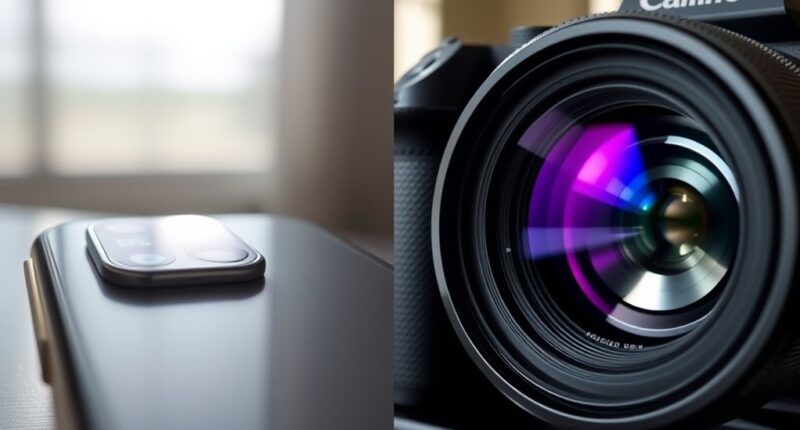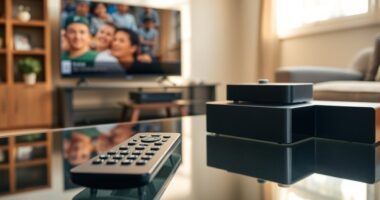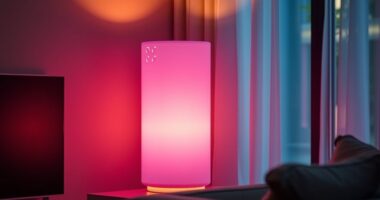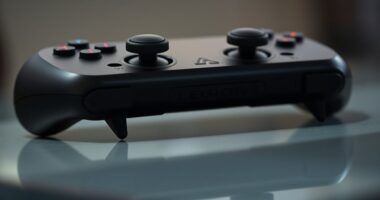The main reason mirrorless cameras outperform smartphones lies in their larger sensors, which gather more light and capture finer details with better color accuracy. They also accept interchangeable lenses, allowing you to adapt to different scenes and create natural background blur. These physics principles improve low-light performance and overall image sharpness. If you want to understand how sensor size, lens versatility, and light collection influence quality, keep exploring these fundamental differences.
Key Takeaways
- Larger sensors in mirrorless cameras capture more light, resulting in better detail, color accuracy, and low-light performance.
- Interchangeable lenses in mirrorless systems provide optical versatility and improved background blur compared to fixed smartphone lenses.
- Bigger sensors and optics in mirrorless cameras reduce diffraction and optical aberrations, enhancing overall image sharpness.
- Mirrorless cameras allow precise manual adjustments of focus and exposure, optimizing optical quality in various conditions.
- Smartphone computational photography compensates for smaller sensors but cannot fully replicate the optical physics of larger, dedicated camera systems.

When choosing between smartphone cameras and mirrorless systems, it’s important to understand their core differences. The fundamental factor that sets them apart is sensor size. Mirrorless cameras feature considerably larger sensors, which means they can gather more light and capture finer details. In contrast, smartphone sensors are tiny, limiting their ability to produce high-quality images, especially in challenging lighting conditions. Larger sensors excel at capturing accurate colors, smooth tonal shifts, and sharp details, even in low light, without introducing excessive noise or grain. Smartphone cameras, relying on small sensors, often struggle in these environments, and their images can look noisy or washed out on large displays. They also rely heavily on computational photography to enhance images, which can sometimes result in unnatural-looking photos. Mirrorless cameras, on the other hand, produce images that are naturally sharper and clearer, making them ideal for large prints or detailed editing.
Mirrorless cameras have larger sensors for better detail and low-light performance than tiny smartphone sensors.
Another core difference is lens flexibility. Mirrorless systems accept interchangeable lenses, allowing you to choose from ultra wide-angle to super telephoto options. This versatility means you can adapt your equipment to different scenarios, capturing expansive landscapes or distant wildlife with full resolution and minimal quality loss. Smartphones, by design, have fixed lenses, often supplemented with digital zoom. Digital zoom enlarges pixels rather than using optical methods, leading to reduced image quality. Because of their smaller aperture and sensor size, smartphones also can’t replicate the natural background blur, or bokeh, that mirrorless cameras can achieve with the right lenses. This flexibility in lens options greatly broadens your creative possibilities and elevates image quality beyond what smartphones can deliver. Additionally, mirrorless cameras often have advanced image stabilization systems that help produce sharp images even in handheld shots.
Manual controls are another area where mirrorless cameras shine. They offer thorough adjustments over exposure, focus, ISO, and shutter speed, giving you precise control over your shots. This level of customization is essential for professional or creative photography, allowing you to adapt settings in real time to different conditions. Smartphones have made strides with manual modes, but they still can’t match the depth and responsiveness of dedicated systems. Their automatic settings and computational features help, but often at the expense of natural, true-to-life results. You’re limited in how much you can tune your images before post-processing.
Low light performance further emphasizes the physical advantages of mirrorless cameras. Larger sensors collect more light, enabling better detail and color accuracy in dim environments. They can support longer exposures and higher ISO settings without excessive noise. Smartphones attempt to compensate through software, but this often leads to grainy images that lack the fidelity of those captured with dedicated cameras. Overall, mirrorless systems provide a more reliable and natural approach to low light photography, essential for capturing moments in less-than-ideal lighting conditions. This physical advantage is especially noticeable in genres like astrophotography or indoor event photography, where light is limited.
Frequently Asked Questions
How Does Sensor Size Affect Image Quality in Smartphones vs. Mirrorless Cameras?
Sensor size directly impacts your image quality because larger sensors gather more light, resulting in brighter, clearer photos with less noise. In smartphones, smaller sensors limit light capture, especially in low-light conditions, reducing image clarity. Mirrorless cameras have bigger sensors, allowing for better light sensitivity, dynamic range, and creative control like depth of field. So, bigger sensors help you produce higher-quality images, especially in challenging lighting scenarios.
What Role Does Lens Quality Play in Optical Performance Differences?
You see, lens quality plays a vital role in optical performance. When you use a high-quality lens, it features complex glass elements that reduce distortions and aberrations, resulting in sharper, clearer images. Better coatings minimize flare and ghosting, boosting contrast and color accuracy. Larger apertures allow more light in for better low-light shots and natural bokeh. Interchangeable lenses let you optimize your setup for different scenarios, elevating overall image quality compared to basic smartphone lenses.
Can Software Enhancements Compensate for Physical Optical Limitations?
You might think software can fully fix optical issues, but it can’t. For example, smartphone software improves distortion correction by about 42%, yet residual distortion still lingers. While AI and multi-frame fusion enhance images, they can’t replace the physics of larger sensors and better lenses. So, software helps, but it can’t fully bridge the fundamental optical limitations—your camera’s hardware still plays a vital role in image quality.
How Do Autofocus Systems Compare Between Smartphones and Mirrorless Cameras?
You’ll find that autofocus systems in mirrorless cameras are faster and more accurate than those in smartphones. They use dedicated sensors and advanced algorithms, including AI subject recognition, to track moving subjects reliably. Smartphones rely on software-based focus methods like face detection, which work well for casual shots but struggle with fast-moving or complex scenes. Overall, mirrorless systems give you better precision, especially in challenging conditions.
What Are the Future Technological Developments Expected to Bridge the Gap?
You’re about to see cameras become almost indistinguishable, blending innovation and AI. Future developments like larger sensors, interchangeable lenses, and smarter computational photography will shrink technical gaps. You’ll enjoy professional-quality images in a compact device, with real-time corrections and adaptive AI enhancements. The line between smartphones and mirrorless cameras will blur, empowering you to capture moments with unprecedented clarity, creativity, and convenience—all in your pocket.
Conclusion
So, as you compare smartphone cameras to mirrorless, remember that optical physics still plays the hero. You might think of your phone as a tiny camera drone, but it’s limited by lens size and sensor technology—think of it like trying to fit a high-res DSLR into a pocket. While tech advances fast, the physics behind optics still govern quality. Just don’t expect your phone to replace a mirrorless anytime soon—no matter how clever your AI assistant is.









